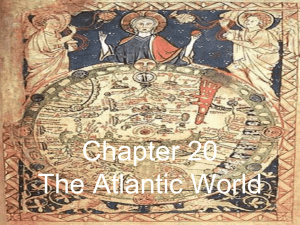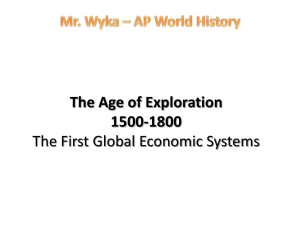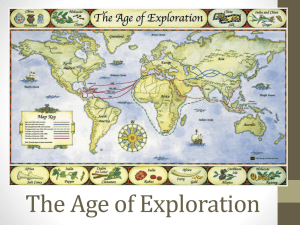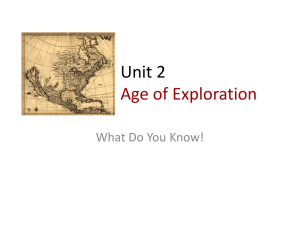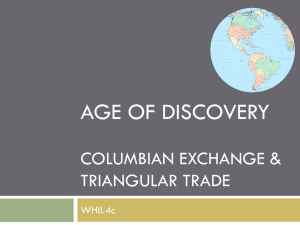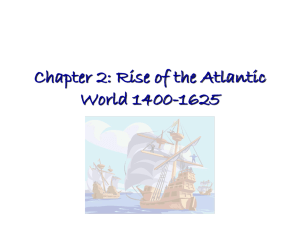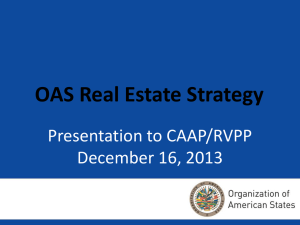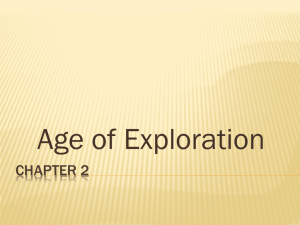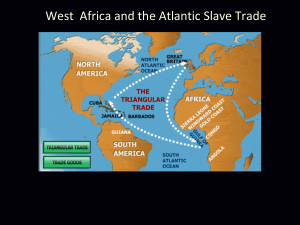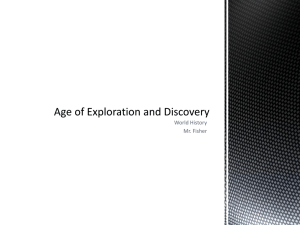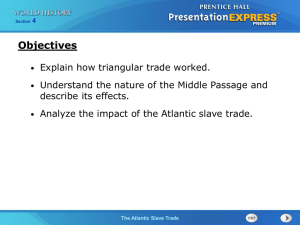The Columbian Exchange & the Trans
advertisement
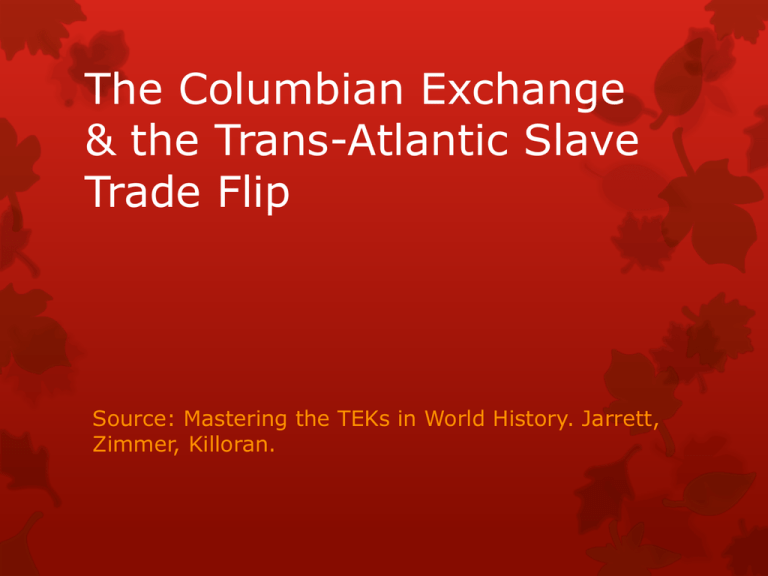
The Columbian Exchange & the Trans-Atlantic Slave Trade Flip Source: Mastering the TEKs in World History. Jarrett, Zimmer, Killoran. They couldn’t just find directions on Google Maps… The goods introduced to Europe during the crusades and the writings of Marco Polo had increased European interest in trade with Asia. Spices, silks, and other goods were carried overland to Constantinople and then shipped across the Mediterranean by the Italian city-states. The conquest of the Byzantine Empire by the Ottoman Turks in 1453 temporarily cut off Europe from overland trade with East Asia, creating a need to find a new route to the East. THE AGE OF DISCOVERY: SPAIN & PORTUGAL LEAD THE WAY Spain and Portugal are located at the western end of Europe on the Iberian Peninsula. Spain has coasts on the Mediterranean Sea and the Atlantic Ocean. Both countries were determined to gain a share of the trade with Asia and had the resources needed to finance costly overseas exploration. Prince Henry of Portugal developed a new, lighter sailing ship and sponsored expeditions along the coast of Africa. Spain’s rulers, Ferdinand and Isabella, had just completed the Reconquista of Spain’s Muslim areas- reuniting the country under Christian rule in 1492. In the same year, they expelled Spain’s Jewish community. Spain’s rulers hoped to further spread the Christian faith and to glorify their country through overseas exploration. In 1492, Spain financed the voyage of Christopher Columbus to find a western trade route to Asia; his accidental “discovery” of the Americas provided new sources of wealth and raw materials that would forever alter the economy of Europe. EUROPEAN EXPLORATION Europeans established new trading-post empires in Africa, Asia, and the Americas. The European states that established new colonies in the Americas were the Portuguese (Portugal), Spanish (Spain), Dutch (Netherlands), French (France), and the British (Great Britain). The Portuguese developed a school for navigation, which led to increased travel to and trade with West Africa, and resulted in the construction of a global trading-post empire. The Spanish will sponsor the first voyages of Christopher and later voyages across the Atlantic and Pacific, dramatically increasing European interest in transoceanic travel and trade. The Northern Atlantic crossings for fishing and settlements continued and spurred European searches for multiple routes to Asia. The Dutch had a small holding in Latin America. As new connections were made between the Eastern and the Western hemispheres, the Columbian Exchange developed. THE COLUMBIAN EXCHANGE The Americas became known as the New World, and Europe, Africa, and Asia became known as the Old World. Columbus’ encounter with the peoples of the Americas quickly led to an important exchange of products and ideas between the New World and the Old World, known as the Columbian Exchange. • 3 Main Elements of the Columbian Exchange: • Food Products • Livestock • Diseases Columbia Exchange: Causes Long-Term Causes Immediate Causes New technologies Columbus and other Europeans arrive in the Americas Europeans search for a sea route to Asia Europeans encounter new plants & animals in the Americas Columbia Exchange: Effects Immediate Effects Millions of native Americans die from diseases Enslaved Africans sent to the Americas American foods introduced into Europe Long-Term Effects Exchange of ideas, foods, art, & language b/w Europe & Americas Population migration from Europe to the Americas Growth of capitalism Connections to Today • Multicultural societies in the Americas • Worldwide reliance on staples such as corn and potatoes THE ATLANTIC SLAVE TRADE Finding enough workers able to survive harsh working conditions became a major problem for many of the colonies, especially in the Caribbean. The solution to the problem led to one of the most negative aspects of the European conquest of the Americas—the rise of the Trans-Atlantic slave trade. Slavery had existed in Africa long before European intervention. However, the new Atlantic slave trade expanded the institution of slavery on a scale unparalleled in human history. THE ATLANTIC SLAVE TRADE Enslaved people were usually captured by powerful African tribes in raids on neighboring villages. The slaves were brought to the West Coast of Africa where they were imprisoned in fortified castles and traded to European and American slave traders in exchange for guns and other goods. THE MIDDLE PASSAGE It is estimated that the Atlantic slave trade took away as many as 15 million African men and women over the next three hundred years. More than 11 million of these went to the Spanish colonies. Many died during the “Middle Passage,” the voyage across the Atlantic, because of the horrible conditions they endured on board the ships. Once they arrived in the Americas, most Africans worked long hours in the sugar fields of the Caribbean and Brazil, or worked raising tobacco and cotton in North America. THE LEGACY OF THE TRANSATLANTIC SLAVE TRADE ON AFRICA Encouraged African Warfare Disrupted African Culture Increased Cultural Diffusion The slave trade encouraged tribes to go to war with each other to obtain slaves to trade for European guns, rum, and other goods. The slave trade destroyed much of Africa’s rich heritage and disrupted its development. It created a legacy of violence, bitterness, and social upheaval The exchange of ideas and goods increased. Slave traders brought new weapons and other goods to Africa, while slaves brought their beliefs, legends, and music to the Americas.
